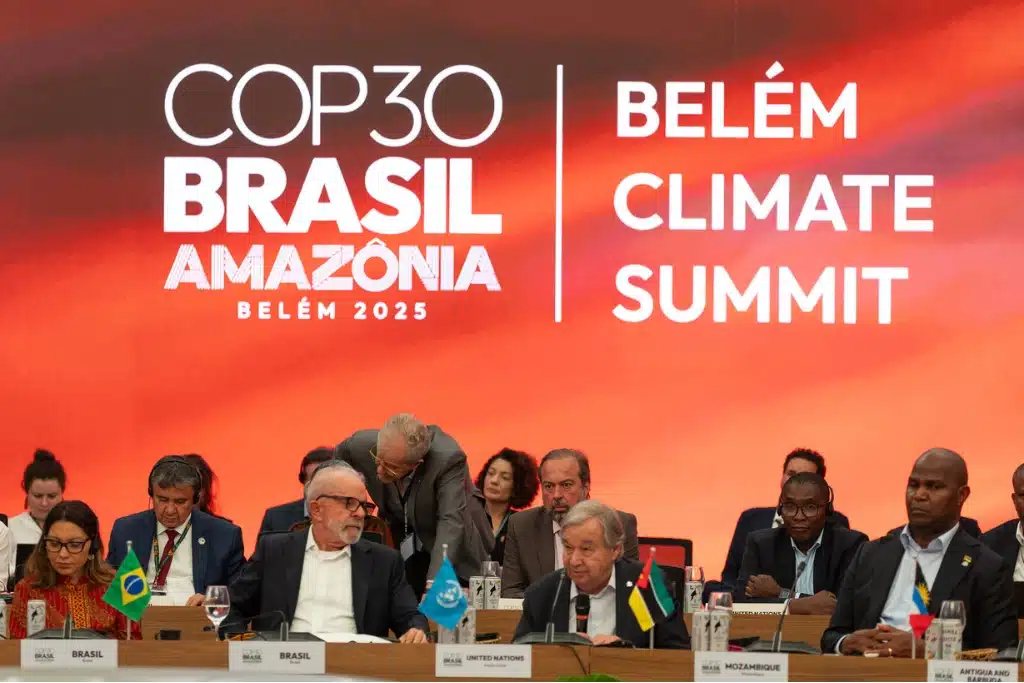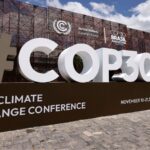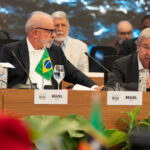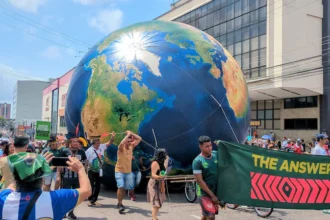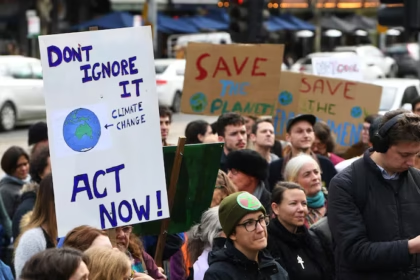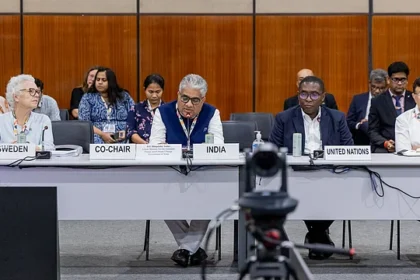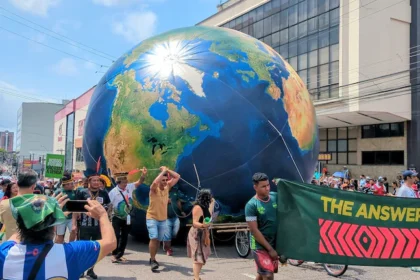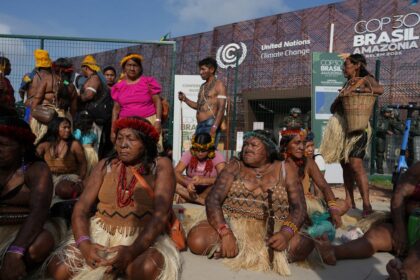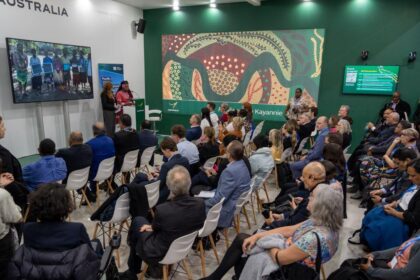One year ago, the participants in the COP29 global climate meeting in Baku, Azerbaijan, came to an early morning agreement well past the planned end of the sessions. However, the relatively spineless decision that resulted in “Matters relating to finance” managed to please almost nobody. Now, as COP30 begins in Belém, Brazil, details are beginning to emerge on whether these new goals can be achieved – and whether the goals were sufficient in the first place.
Global targets for climate finance were set as early as 2009 in Copenhagen, when participants agreed that the world’s wealthiest countries would raise $100 billion per year by 2020, with the aim to support measures in developing countries to address climate change. This was further formalized under Article 9 of the 2015 Paris Agreement, where it was agreed that “[d]eveloped country Parties shall provide financial resources to assist developing country Parties with respect to both mitigation and adaptation.”
In 2021, the same countries agreed to double 2019 international adaptation finance (around $20 billion) to $40 billion by 2025. While this goal has yet to be achieved, prior to last year’s COP29 in Baku, developing countries hoped that yet a climate finance target – known as the New Collective Quantified Goal (NCQG) – would meet their “needs and priorities”, as set out in the Paris accord.
The late decision in Baku last year calls on all actors “to work together to enable the scaling up of financing to developing country Parties for climate action from all public and private sources to at least $1.3 trillion per year by 2035.” More concretely, a goal was set, “with developed country Parties taking the lead, of at least $300 billion per year by 2035 for developing country Parties for climate action.”
While these numbers appeared substantial at first glance, they were relatively unambitious, and left developing countries less than impressed. For one, the decision merely calls for (rather than commits to) $1.3 trillion – the amount needed to deal with the consequences of climate change, according to experts. Furthermore, the more concrete $300 billion goal was already close to being met without any additional effort; pre-existing national pledges and multilateral development bank plans were indeed on track to bring adaptation finance up to as much as $265 billion annually by 2030.
Indian delegate Chandni Raina expressed disapproval of the climate aid deal struck at the COP29 Climate Conference in Baku, Azerbaijan on November 24, 2024.
Indian delegate Chandni Raina expressed disapproval of the climate aid deal struck at the COP29 Climate Conference in Baku, Azerbaijan on November 24, 2024. Photo: screenshot.
According to the recent State of Climate Action report from Systems Change Lab, global climate finance flows have to date not scaled up at the rate needed to meet the 1.5C global warming goal.
“Although flows more than doubled between 2019 and 2023, from $0.9 trillion to $1.9 trillion, global efforts to accelerate total climate investment remain well off track, requiring acceleration roughly four times faster than current growth to reach the 2030 target,” the report states. Investment is running at just 37% of the levels required for the rest of this decade if the world is to get on track for net zero by 2050, according to Bloomberg NEF.
At next week’s COP30 discussions in Brazil, therefore, countries are expected to tackle climate finance from a broader perspective.
“Finance is the great accelerator,” UN Climate Change Executive Secretary Simon Stiell said at the Leaders’ Summit in Belém this week.
“The Baku to Belém Roadmap charts the path from $300 billion a year to $1.3 trillion by 2035 – and it must become reality. This is shared interest, not charity – an investment in stability and prosperity. Every dollar invested in climate solutions brings multiple dividends: jobs, cleaner air, better health, resilient global supply chains, stronger energy and food security. To unlock that transformation, finance must be scaled up, sped up, and spread out – reaching every nation, fast, fair, and in full,” Stiell said.
According to Rachel Simon, Senior Policy Coordinator at Climate Action Network, countries at COP30 will be looking at the entirity of the global financial system, including all financial flows.
“They’ll be looking at how international financial institutions can address debt, sovereign debt, and what multilateral development banks can address. They’ll see what agreements they can set up, how they can address systemic issues, and target illicit financial flows,” Simon told Earth.Org.
“One issue is that there is no clear climate finance definition. It’s open to interpretation. There’s meant to be a balance between mitigation and adaptation, but there is far more money going to mitigation,” she added.
When interpreted in its broadest sense, climate finance includes any flows originating from public or private sources. On the public side are governments and various public financial intermediaries, while the private side includes corporates, households, project developers, and private financial intermediaries.
At the time when the Paris Agreement was signed, financial flows from all these parties already averaged $410 billion per year, and went on to exceed $2 trillion as of last year. However, this includes everything from public investment to individual households buying electric cars or heat pumps.
A potential new adaptation finance goal for COP30 might be for the parties to heed a call made in June by the Least Developed Countries Group to at least triple the existing goal, ideally using a previous pledge as a baseline for 2025.
Baku to Belém Roadmap
This week, in part to help clarify the questions raised by the previous decisions, the UN Framework Convention on Climate Change (UNFCCC), the UN’s climate arm, issued the Report on the Baku to Belém Roadmap to 1.3T. The document aims to “provide a coherent action framework reflecting initiatives, concepts and leverage points to facilitate all actors coming together to scale up climate finance in the short to medium term.”
It outlines five “action fronts” to help deliver on the $1.3 trillion aspiration, incorporating regional considerations, with a deliberate focus on addressing the needs of the poor and particularly vulnerable, including Small Island Developing States and Least Developed Countries. It also sets out short-term deliverables.
“The Baku to Belém Roadmap turns a promise made at COP29 into a plan,” Melanie Robinson, Global Director of Climate, Economics and Finance at World Resources Institute, said in a statement. “It charts a smart, holistic strategy to deliver $1.3 trillion a year in climate finance for developing countries, and start transforming the global economy, starting now. For too long, the climate community has been overly focused on relatively modest sums of public climate funding, whereas the Baku to Belém plan rightly shifts the lens to how a wider set of public finance and policy shifts can unlock much larger flows from private investors.”
However, the plan can only be considered a theoretical proposal without buy-in from the parties at COP30. The plan itself states: “The Roadmap should not be interpreted, in any way, as an attempt to prejudge the Party-driven process on the implementation of the NCQG decision.”
One clue to the future implementation of the Baku decisions may lie far from Belém, in Nairobi, Kenya. There, negotiations will take place on the UN Framework Convention on International Tax Cooperation, simultaneously with COP30. Key topics will be discussed such as the equity principle, which takes into account the respective capacities and backgrounds of both developed and developing countries to set out progressive, domestic and international taxes.
For developing countries, key financial barriers to addressing climate change include debt, lack of international tax cooperation rules, and the cost of credit.
The World Bank’s Independent Evaluation Group estimates that nearly $200 billion flowed out of developing countries to private creditors from developed countries in 2023. With most credit rating agencies located in the developed world, credit is expensive and difficult to access for developing nations. More efficient tax systems and better international tax cooperation rules may also help reduce offshoring, a key barrier to climate-friendly tax policy.
Another financial barrier to addressing climate change that may be addressed in both Belém and Nairobi is ongoing fossil fuel subsidies.
“The world has seen a troubling rise in public fossil fuel finance. This is completely unacceptable,” said Neil Grant, Senior Expert of Climate Policy Analysis at Climate Analytics, in a recent seminar. Subsidies represent the largest form of financial support for fossil fuels, and totaled $1 trillion in 2023, with Russia, Germany, and Iran providing the largest amounts. Public financial flows for fossil fuels have been increasing by an average of $75 billion per year over the last 10 years.
US Absence
One voice that will not be present at COP30 is the US. While the country was instrumental in the original $100 billion goal, the first Trump administration made its decision to withdraw from the Paris Agreement within days of its signing, meaning that commitments made under the previous Obama administration were canceled. Later, although the Biden administration re-joined, the European Union remained the world’s largest provider of climate finance, while the US focused on private finance and carbon credits to fill the gap as opposed to public finance.
Now, under the second Trump administration, not only are all national climate finance projects being shut down or wound up, but the country’s leadership is engaging in intimidation tactics to derail progress.
“The US has played a very damaging role,” commented Simon.
For Small Island Developing States, which received just 5% of external climate finance flows, the topic goes far beyond business interests.
by: Jan LeeGlobal CoCommons
Source: www.earth.org

